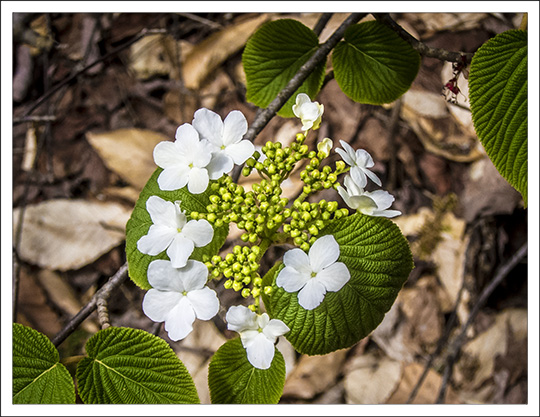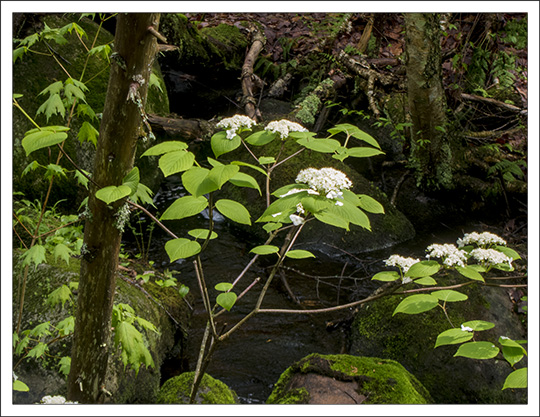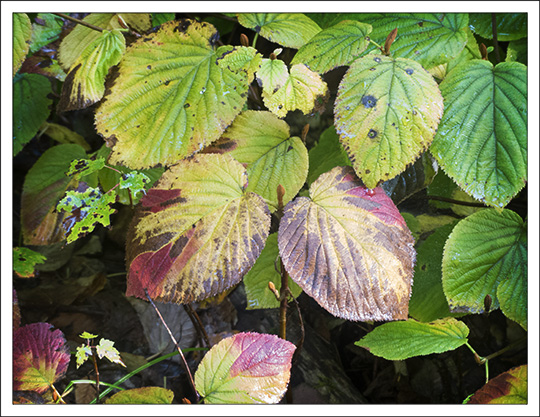Adirondack Shrubs:
Hobblebush (Viburnum lantanoides)
 Adirondack Shrubs: Hobblebush (Viburnum lantanoides) on the Heron Marsh Trail (8 May 2013)
Adirondack Shrubs: Hobblebush (Viburnum lantanoides) on the Heron Marsh Trail (8 May 2013)
| This page is no longer being updated. For an updated and expanded version of this material, see: Hobblebush (Viburnum lantanoides). |
Hobblebush (Viburnum lantanoides) is a native deciduous shrub which abounds in rich, moist woods throughout the Adirondack Mountains. It produces flat-topped clusters of fragrant white flowers in the spring. The clusters are 2-6 inches wide; the flowers on the outer edge of each cluster are much larger than those in the middle. The large showy flowers along the edge of the cluster are sterile, while the small inner flowers have both male and female parts. The heart-shaped leaves are prominently veined and finely saw-toothed, with rust-colored hairs on the undersides. The flowers are followed in September by red berries gradually changing to dark blue, and attractive bronze-red or purple foliage in the fall. The shrub grows to a height of three to six feet.
Hobblebush is a member of the Honeysuckle Family (Caprifoliaceae). The name Hobblebush refers to the fact that the plant has pendulous branches which form obstacles which easily trip (or hobble) walkers. This plant is also known as Witch-Hobble, Moosewood, and Alder-leaved Viburnum.
 Adirondack Shrubs: Hobblebush (Viburnum lantanoides) on the Barnum Brook Trail (22 May 2013)
Adirondack Shrubs: Hobblebush (Viburnum lantanoides) on the Barnum Brook Trail (22 May 2013)
Hobblebush serves a variety of wildlife. Browsers eat its twigs and leaves. Game birds, songbirds, and mammals eat the fruit. In addition, Hobblebush is said to be larval host and/or a nectar source for the Spring Azure butterfly.
The fruit of the Hobblebush reportedly may be eaten raw or cooked and is said to taste somewhat like raisins or dates. Hobblebush has a number of medicinal uses. The Algonquin reportedly rubbed its mashed leaves on the head to treat migraines. Iroquois are said to-have used a decoction of roots as a blood medicine. The plant was also used to treat chest and breathing problems.
Hobblebush grows in rich, moist woods, by stream banks, and in swamps. It flourishes in the north eastern portions of the US and Canada, including New York State. Hobblebush is very common in the cooler parts of New York State, including the Adirondacks, where it can form dense thickets. The plant may also be found south to Georgia, Tennessee, and North Carolina.
 Adirondack Shrubs: Hobblebush (Viburnum lantanoides) on the Logger's Loop Trail (11 September 2013)
Adirondack Shrubs: Hobblebush (Viburnum lantanoides) on the Logger's Loop Trail (11 September 2013)
At the Paul Smiths VIC, Hobblebush may be found along most trails. It usually blooms in this part of the Adirondack Park in May, depending on the weather.
References
- Lady Bird Johnson Wildflower Center. Native Plant Database.
- United States Department of Agriculture. Plants Database.
- University of Michigan. Native American Ethnobotany. A Database of Foods, Drugs, Dyes and Fibers of Native American Peoples, Derived from Plants.
- NatureServe Explorer. Online Encyclopedia of Life.
- Plants for a Future. Database.
- Connecticut Wildflowers. Wildflower Guide.
- New York Flora Association. New York Flora Atlas.
- ENature. Wildflower Field Guide.
- National Audubon Society. Field Guide to Wildflowers. Eastern Region. (Alfred A. Knopf, 2001), p. 465.
- William K. Chapman, et al. Wildflowers of New York in Color (Syracuse University Press, 1998), pp. 22-23.
- William K. Chapman and Alan E. Bessette. Trees and Shrubs of the Adirondacks: A Field Guide (North Country Books, 1990), p. 107.
- Anne McGrath. Wildflowers of the Adirondacks (EarthWords, 1981, 2000), p. 6, Plate 3.
- Ruth Schottman, Trailside Notes: A Naturalist's Companion to Adirondack Plants (Adirondack Mountain Club, 1998), pp. 126-129.
